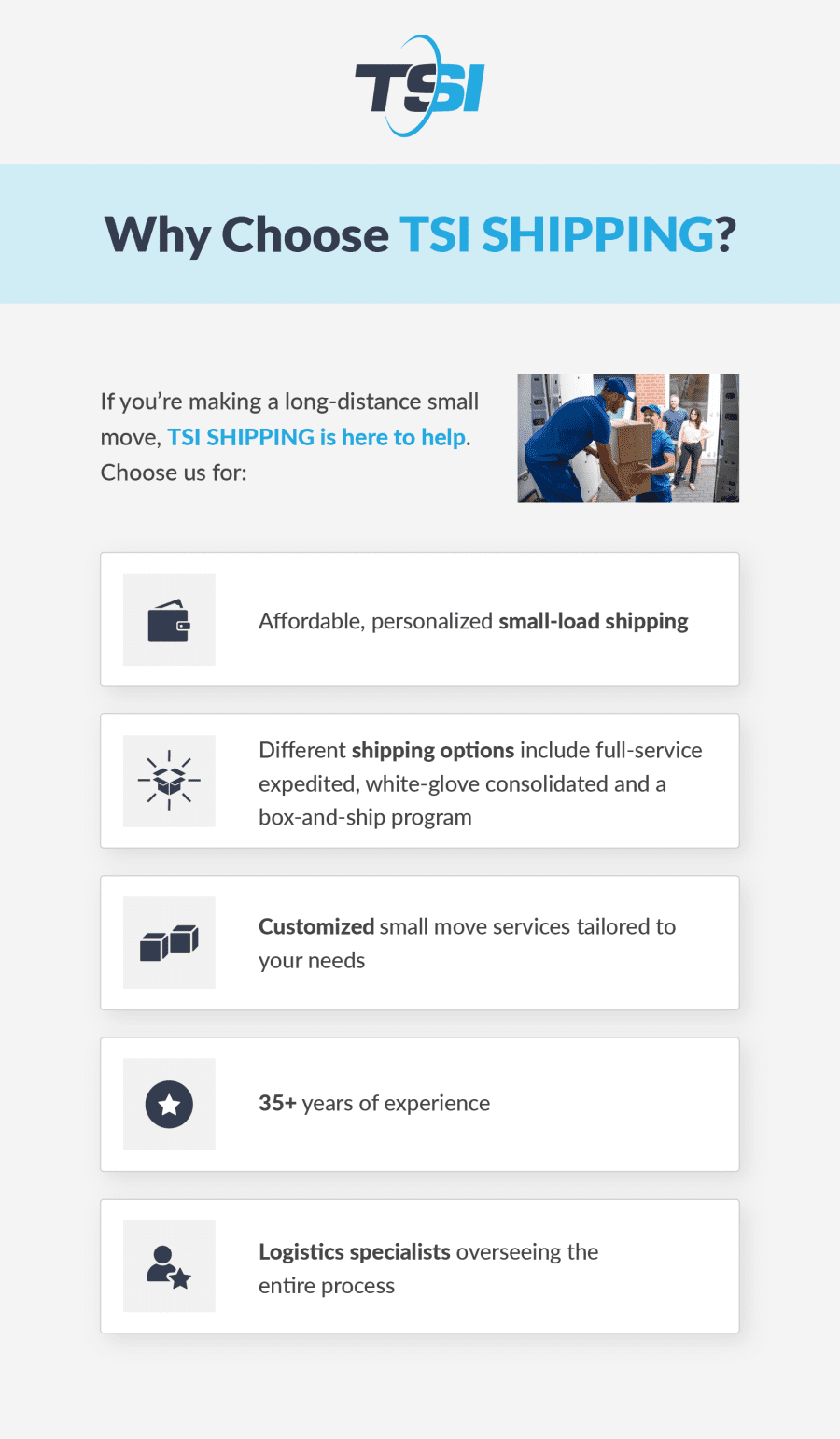TSI is happy to provide you with information related to shipping and moving. If and when you’d like more details for shipping your heavy items, you can request a quote or call us at 1-800-626-1257. We’ve been leading the way in small moves and specialty shipments nationally for more than 30 years and are A+ rated by the Better Business Bureau.
Calculating shipping costs and choosing the most economical shipping method can be confusing. Our Cheapest Way to Ship Anything guides make it easy to compare shipping costs and choose the right method for your cargo, whether you're shipping common items like boxes or difficult-to-transport goods like antiques or artwork.
Jump to:
1. How Much Does it Cost to Ship Heavy Items?
We've calculated shipping costs for three common shipping methods: USPS, parcel shipping, and consolidated freight.
i. USPS shipping costs
ii. Parcel shipping costs (eg. UPS or FedEx)
iii. Consolidated freight
2. Frequently Asked Questions
Get answers to the most frequently asked questions about shipping heavy items.
Thanks to their heft, heavy items can be awkward to ship or move. To complicate matters further, there is no commonly accepted definition of what is considered a “heavy package”. Every carrier defines it differently:
- USPS cannot carry packages over 70 lbs and has no heavy item distinctions.
- UPS and FedEx define any package over 70 lbs as heavy.
- Consolidated freight providers consider items over 125 lbs to be heavy but do not have maximum weight limits.
Heavy items can include things like auto parts, mattresses, gym equipment, or pallets of packed boxes. There are many reasons why you might need to ship heavy items, such as:
- You’re a retailer sending heavy purchases to customers, including artwork or equipment
- You’re relocating a business and are sending heavy items and equipment to other locations
- You’re moving long-distance and are shipping heavy boxes, furniture, artwork, or household goods your new home
Whatever your reason, there are a number of special considerations to keep in mind when shipping heavy items:
- Weight limits: Most shipping companies have a weight limit on how much they can carry. USPS cannot carry packages over 70lbs, for example. FedEx and UPS have weight limits for flat rate shipping but can carry heavier packages using other shipping services. Consolidated freight shippers are the most capable of carrying heavy items and don’t have maximum weight limits to worry about.
- Accurate measurements: It’s especially important when shipping heavy items to make sure you accurately weigh and measure your package. Providing accurate information to your shipping provider will help you avoid incurring unexpected oversize or overweight surcharges.
- Speed of delivery: Ground shipping is the most cost-effective way to ship heavy boxes, but it may take longer to deliver your items. LTL ground shipping typically takes 3-5 business days from pickup to delivery, so if you need fast delivery, you’ll need to use air freight, which will significantly increase the cost of shipping heavy items.
- Packaging: Heavy items are more likely to be carried by forklift, so your packaging needs to be capable of handling heavy weights while withstanding the rigorous carrying practices these packages require. Always use new, strongly constructed boxes, ideally with stitched or stapled seams, or consider crating and palletizing especially heavy items. Heavy items are also more likely to shift in transit, and standard packing materials like crumpled paper or bubble wrap may not be sufficient to prevent damage. Corrugated board or engineered foam enclosures are often recommended, but can add to your shipping costs.
- Fragility: Heavy items are more prone to damage because they can be difficult to carry and are more likely to shift in transit. If your heavy items are fragile, you’ll want to work with a shipping provider that has the experience to help you properly pack and transport these items safely.
- Physical ability: Some freight shippers will require you to carry your cargo to the curb for loading, and parcel shippers may not be able to schedule at-home pickup or delivery for certain items or locations. In these cases, you’ll need to have the physical ability to carry your heavy items to the curb or into the store. You may need tools like dollies or a hand truck to help out.
- Insurance: Because heavy items are more susceptible to damage than lighter packages, you may want to purchase additional insurance to protect your shipment in the event it sustains damage, especially if you’re shipping valuable or antique items.
Need help shipping heavy items?
Take a look at our furniture shipping solutions page. Getting a price is easy, simple and straightforward.


How much does it cost to ship heavy items?
The cheapest way to ship heavy items depends on the exact weight of your cargo and the distance it will travel. Consolidated freight is typically the cheapest way to ship heavy packages.
Compare shipping rates for heavy items using the most common shipping methods:
- USPS
- Parcel shipping (such as FedEx or UPS)
- Consolidated freight
At TSI, we see two common types of heavy item shipments: single heavy items and pallets of boxes. To help you compare shipping costs, we’ve included costs for two sample shipments of heavy items:
- A single item weighing 300 lbs
- A shipment of 15 palletized boxes weighing a total of approximately 525-550 lbs
The shipping cost estimates for variable pricing provided below will be based on these common sizes and weights.
USPS
USPS cannot transport any item over 70 lbs, and is therefore not ideal for heavy packages.
If your package weighs less than 70 lbs, flat rate shipping is the cheapest option. Learn more about shipping flat rate boxes with USPS.
If you need faster delivery or a larger box size, you’ll need to use a variable pricing service.
Parcel shipping (UPS or FedEx)
Parcel shippers like UPS and FedEx have their own sets of rules when it comes to packing heavy items.
UPS considers any package over 70 lbs to be “heavy”. For items over 70 lbs, UPS requires you to attach a “heavy package” sticker directly beside the address label with the weight of the package clearly legible, and your package must meet UPS Box Strength Guidelines. If your package weighs over 150 lbs, you’ll need to ship it through UPS Freight. The cost of UPS Freight shipping depends on whether you need ground freight or air freight, as well as the freight class of your items. Additional charges will apply for value-added services like use of liftgate, inside pickup or delivery, limited access, and extreme length.
FedEx offers a number of shipping options for heavy items. The right service depends on the weight of your heavy item. FedEx Home Delivery can transport packages up to 70 lbs, while items between 70-150 lbs will be considered “heavy” and will be shipped through FedEx Ground. Any package over 75 lbs requires a safety label placed over the diagonal corners of the package. This safety label can only be acquired by contacting FedEx directly. For packages over 150 lbs, you’ll need FedEx Express Freight or FedEx Freight. 3 day, 2 day, 1 day, and overnight delivery is available with FedEx Freight services.
Compare FedEx shipping options for heavy items below:
| Service | Weight limit | Notes |
|---|---|---|
| FedEx Express U.S. Services FedEx Ground FedEx Home Delivery |
Packages under 150 lbs | Suitable for packages up to 119” in length and 165” in length and girth (130” for international shipments) |
| FedEx Express Freight | Individual skids of 150 lbs or more | Skids exceeding 2,200 lb, 70” in height, 119” in length, or 80” in width will require prior approval |
| FedEx Freight | Up to 20,000 lbs | Shipment can be palletized or not |
Here’s how much you can expect to pay to ship heavy items using parcel shipping freight services:
| Weight | Philadelphia → Miami | Philadelphia → Los Angeles | Chicago → Dallas | Cleveland → San Diego |
|---|---|---|---|---|
| 300 lbs (single item) | UPS: $716.44-$2,139.50 FedEx: $60.32-$389.22 |
UPS: $1,051.74-$2,717.00 FedEx: $2,452.61-$4,333.62 |
UPS: $551.48-$1,927.80 FedEx: $1,043.96-$2,959.44 |
UPS: $988.30-$2,614.80 FedEx: $2,269.74-$4,150.74 |
| 550 lbs (15 palletized boxes weighing approximately 35 lbs each) | UPS: $1,015.69-$4,623.71 FedEx: $799.65-$4,661.12 |
UPS: $1,504.32-$5,888.63 FedEx: $1,377.15-$5,668.39 |
UPS: $1,504.32-$4,160.62 FedEx: $799.65-$4,661.12 |
UPS: $1,413.17-$5,667.90 FedEx: $1,377.15-$5,668.39 |
Shipping cost estimates are calculated using individuals providers’ online cost estimator tools. Details, exact prices, and shipping times are not guaranteed.
Consolidated freight (TSI)
Consolidated freight shippers specialize in transporting heavy and difficult-to-transport items. Unlike parcel carriers, freight shippers do not have any special requirements for heavy items—items are considered heavy and may require special equipment when they exceed 125 lbs, but there are no “heavy package” designations to worry about.
Heavy items are commonly loaded and unloaded using a forklift, but the driver may also use a pallet jack to push your cargo onto a liftgate before lowering it to the curb. Proper packing will ensure your cargo stays safe throughout this process, but the correct packing method ultimately depends on what you’re shipping:
- Some items, such as household goods or general merchandise can be safely boxed with the appropriate padding and packing materials
- Delicate or valuable items such as engines, transmissions, car parts, and other equipment should be crated for the most protection
- Shipments of 15 or more boxes or especially heavy boxes should be palletized so they are easy to load and unload from the truck. TSI can help palletize your boxes for an additional fee.
Additional charges will apply for White Glove shipments such as heavy furniture, artwork, or valuable items that weigh over 300 lbs. These items cannot be transported by forklifts or other heavy machinery, and instead will require additional labor—typically a third person—to move them safely.
There may also be additional charges for use of liftgate for items 150 lbs or heavier, as well for delivering to a residence—residential addresses typically don’t have the facilities to send and receive heavy items, such as loading docks, and extra attention or equipment may be required. Most commercial facilities have a loading dock and the means to safely load and unload a shipment. When requesting a quote, be sure to describe what facilities or equipment are available so your logistics specialist can provide an accurate quote.
We’ve put together two examples of heavy item shipments to give you an idea of how much it costs to send heavy items through consolidated freight:
- One single 300 lb item, not including liftgate charges
- A pallet of boxes weighing 550 lbs, including liftgate charges
| Weight of shipment | Philadelphia → Miami | Philadelphia → Los Angeles | Chicago → Dallas | Cleveland → San Diego |
|---|---|---|---|---|
| 300 lbs (single item) | $700.69 | $873.25 | $588.08 | $789.51 |
| 550 lbs (15 palletized boxes) | $919.20 | $1,119.34 | $781.82 | $1,053.75 |
NOTE: Box size does not factor into freight pricing.

COVID-19 Precautions
TSI is carefully monitoring all of our shipments nationwide. We have seen minimal delays thus far, and are in constant contact with transportation industry leaders in order to be as proactive as possible. All members of the logistics chain are using the safety precautieons recommended by the C.D.C.:
- Clean your hands often (washing for 20 seconds or using hand sanitizer)
- Avoid touching your face
- Avoid close contact
- Stay home if sick
- Cover coughs and sneezes
- Clean and disinfect frequently touched surface
NOTE: Shipping cost estimates are calculated using individual providers’ online cost estimator tools. Details, exact prices, and shipping times are not guaranteed.
Frequently Asked Questions
What’s the cheapest way to ship heavy items?
The cheapest way to ship a heavy package depends on the exact weight of the package. Typically, less-than-truckload shipping is the cheapest way to ship heavy items because freight shipping companies specialize in transporting heavy packages and your cargo will not be subject to a maximum weight limit or oversize package charges.
How much does it cost to ship heavy items?
The cost of shipping heavy items will depend on the exact weight of the package, the shipping method you choose, how far it will travel, and how quickly you need it to arrive.
Here’s a rough idea of how much you can expect heavy items to cost using some of the most popular shipping methods:
USPS
- Cannot ship packages over 70 lbs
Parcel shipping (eg. UPS or FedEx)
-
$551.48-$2,727.00 for a single item weighing 300 lbs, depending on speed and distance of travel.
-
$799.65-$5,667.90 for a pallet of 15 boxes weighing 525 lbs total depending on speed and distance of travel.
Shipping costs may be lower for shorter distances or lighter boxes, or higher for faster delivery
Consolidated freight (eg. TSI)
- $588.08-$873.25 for a single item weighing 300 lbs
- $781.82-$1,119.43 for a pallet of 15 boxes weighing approximately 525 lbs
Shipping costs may be lower for shorter distances.
How do I package heavy items for shipping?
Heavy items need to be transported in packaging that is strong enough to withstand loading and unloading by forklift, temperature and humidity changes, the potential of getting dropped, vibration on the truck, and s compression on all sides as other packages are stacked on top of and around your cargo.
When packing your heavy items, always use new boxes with stapled or stitched seams and strong padding—heavy items are more likely to shift in transit, and common packing materials like bubble wrap or crumpled paper won’t withstand the weight of the item when it shifts. X-pad, air pillows, or custom foam enclosures are typically recommended when shipping heavy items.
For the most protection, safely pack heavy items into a smaller box, then line the outside of that box with bubble wrap before placing it inside another, larger box. This ensures there will be adequate protection in case your heavy item is dropped or punctured.
If you can, consider breaking up your heavy item into smaller boxes. This can help reduce the weight—and maybe the cost—of your shipment.
When should I palletize my heavy items?
You should palletize any item weighing between 125-150 lbs. Some carriers recommend palletizing anything over 100 lbs for added security. Especially heavy items or shipments of more than 15 boxes are always best packed onto a pallet.
What’s the best way to ship heavy items?
The best way to ship heavy items over 150 lbs is through consolidated freight like less-than-truckload (LTL) or white glove shipping.
Consolidated freight carriers don’t use the same systems as parcel carriers, and have more flexibility and freedom to customize your shipping plan without a maximum weight limit or additional surcharges for heavy items.



